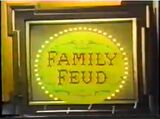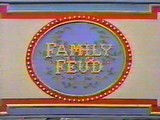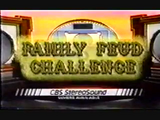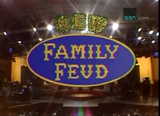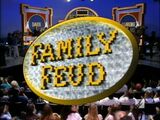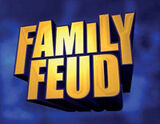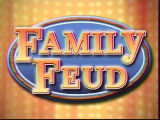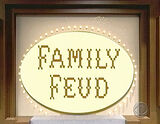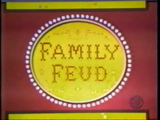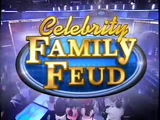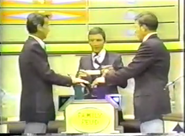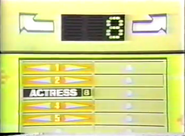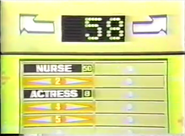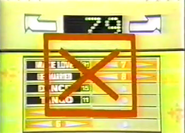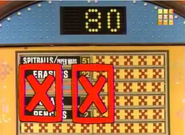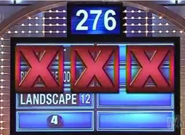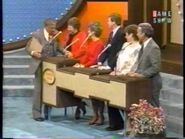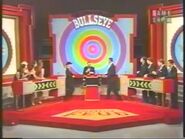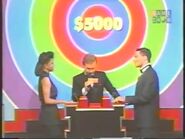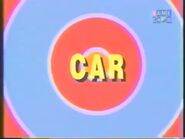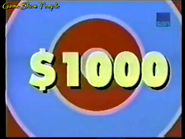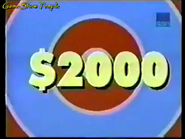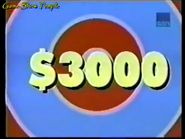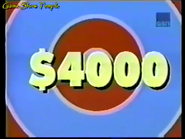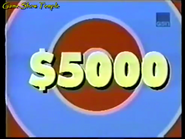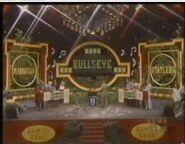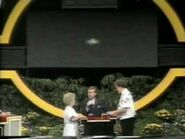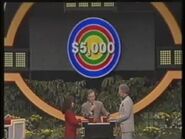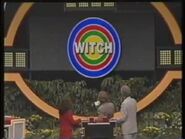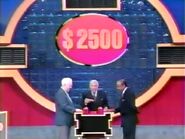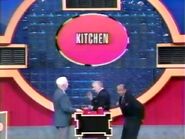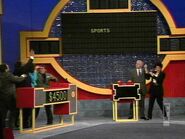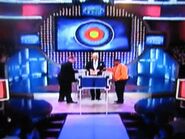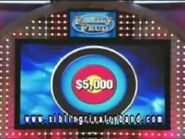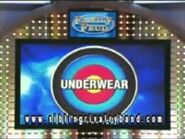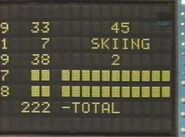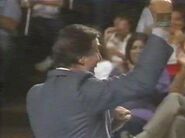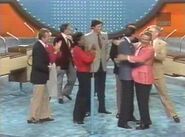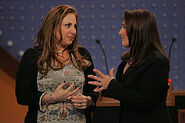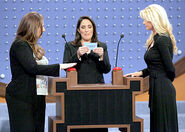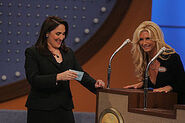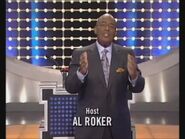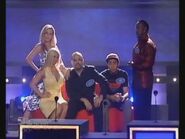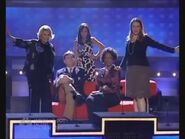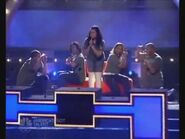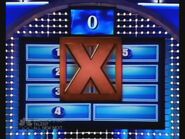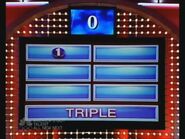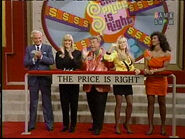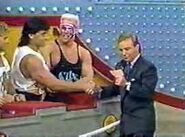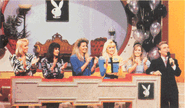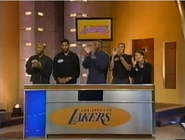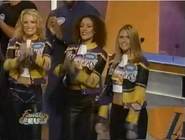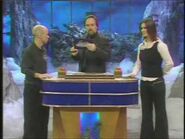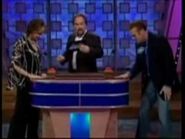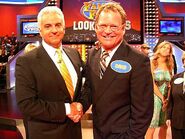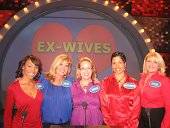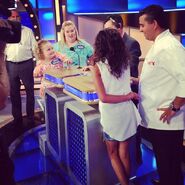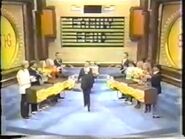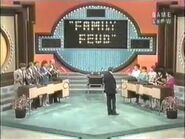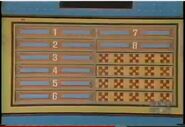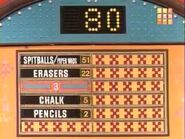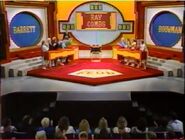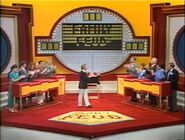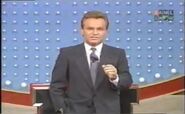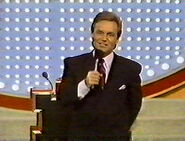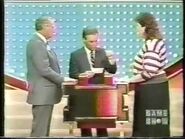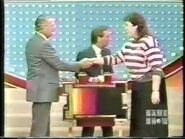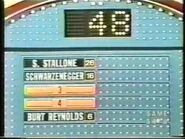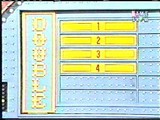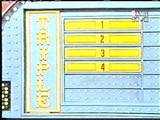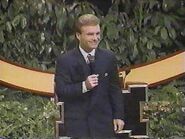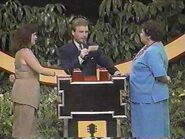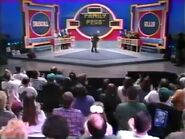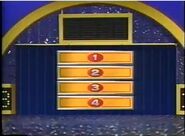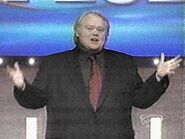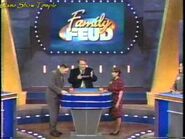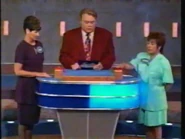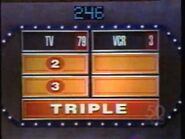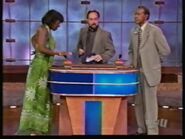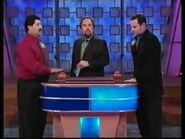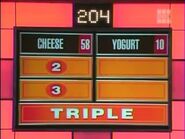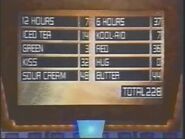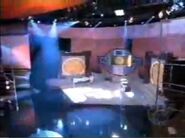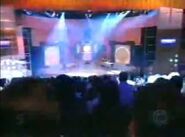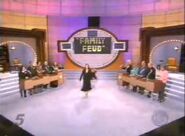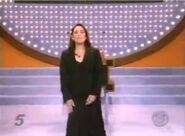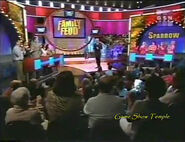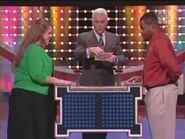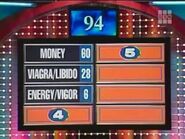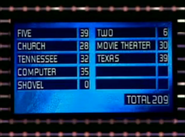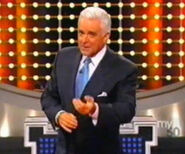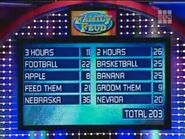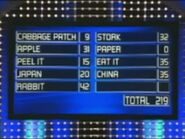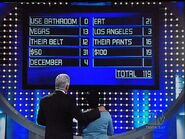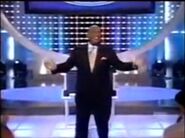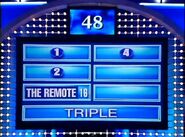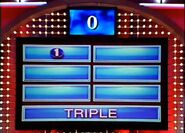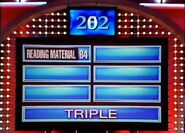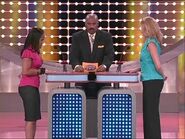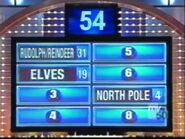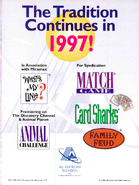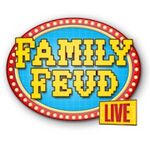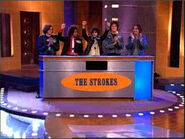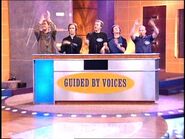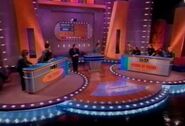| Hosts | |
|
Richard Dawson (Pilot) 1975, 1976-1985, 1994-1995 | |
| Announcers | |
|
Johnny Olson (Pilot) 1975 | |
| Broadcast | |
|
Pilot: 1975
ABC: 7/12/1976-6/14/1985 Syndicated: 9/19/1977-9/13/1985 Pilot: 1987 CBS: 7/4/1988-3/26/1993Syndicated: 9/19/1988-5/26/1995 Syndicated: 9/20/1999-present CBS (Gameshow Marathon): 6/29/2006 NBC (Celebrity Family Feud): 6/24/2008-7/29/2008 | |
| Packagers | |
| Mark Goodson-Bill Todman Productions (1976-1983) Mark Goodson Productions (1983-1985, 1988-1995, 1999-2002) Pearson Television (1999-2002) Fremantlemedia North America (2002-present) | |
| Sub-Packagers | |
| Feudin' Productions, Inc. (1999-2010) Wanderlust Productions, Inc. (2010-present) Georgia Entertainment Industries (2011-present) | |
| Distributors | |
|
Viacom Enterprises (1977-1985) | |
A spin-off from Match Game's big money "Supermatch" bonus round, this show is where two families battle it out by answering surveys to win points. The first to reach a set number of points (originally 200 in the pilot and first season, then 300, and 400 during Dawson's 1984-85 season and their "Tournament of Champions" episode) gets a chance to play Fast Money for a grand cash prize. Each family has 5 members per team, except from 1994 to 1995, when there were only 4 members per team. During the one-hour versions from 1992 to 1995, two new families competed in the first half-hour for the right to face the champions in the second half. Early in Dawson's season, the winners of the first half competed in the second half against a family from the original Dawson era.
Main Game
Face-Off
At the beginning of each round, two members of each family come up to the main podium and play a mini-round for control of the question called "Face-Off". The host announced how many answers are on the board (which are always in order based on popularity), and then read a survey question and the first player to buzz-in gets to answer. The player to give the number one answer or have his/her answer be higher than the other player's answer won control. In case of a tie (both answers with the same number of people who gave it) the player who answered first won control. If neither player gave an answer on the board, the players at the main podiums get a chance to answer for control.
For time reasons, during Louie Anderson's & (some of) Steve Harvey's tenure, if neither player's answer was on the board the question was thrown out, and a new one was played.
During Dawson's first version & the current version, the player that won the Face-Off has a decision to either let his/her family play the question or pass the question to their opponents.
Main Question
The family that won the face-off earns control of the question. The controlling family's job is to reveal the remaining answers hidden on the board with each correct answer adding points to the bank above the board. The answer's value is determined by how many people who gave it. Each player on the controlling team in turn gave an answer and if the answer he/she gave is correct, it is flipped over and revealed. Revealing all the answers on the board won the round (this is classified as a "Clean Sweep"). Giving a wrong answer at any time earned a strike; getting three strikes (one in the final round from 1999 to 2003) caused the team to lose control of the question, giving the opposing family a chance to steal by giving one correct answer. A successful steal won the round, but an unsuccessful steal gave the round to the first family. The winners of the round took all the points in the bank plus (in the pilot, from 1992 to 1995, and again from 1999 to 2003) the value of the correct answer given by the stealing family. After that, the host will reveal the remaining answers if there's anything left on the Survey board starting from the top to the bottom. Since the Steve Harvey's second season, the remaining answers will be revealed from the bottom to the top.
In the Ray Combs eras' later years, whichever team member caused the family to get a strike would have to hold a sign that consisted of a black stick with a white card with the Strike Indicator on it.
Question Values
The first few questions had its values be worth the number showing. Later on in the game, the values of all the questions would be doubled (the double value round wasn't available from 1999 to 2003); and still later, all the point values would be tripled (in the Dawson era and the first four years of the current version, the triple valued question would be the last question of the game).
Winning
The first family to reach a set number of points won the game. For most versions, the goal is 300 points. In the first season of the Dawson run and pilot episode, the goal was 200 points; but in the final season of the Dawson run, the goal was set to 400 points. (In the original Dawson version and his 1994 comeback, when the game takes too long to reach the 300/400 goal, Richard goes to the controlling family to tell them that each teammate has three seconds to answer once he reads the question to them during the TRIPLE Round. Beginning in 2003, when the 300 goal was restored, Karn only read the question once to both families upon Tripling the point values; though he did read it again after the captain of the stealing family gave an answer. In Karn's final season, whenever he read the question once, home viewers were shown the survey question at the bottom of the screen.) From 1999 to 2003 there was no goal; the team with the most points won the game, even though most families in this period reached the goal of 300 points. In addition, there was only one strike for the team in the triple round (round 4). This created a scenario in which a team could give an incorrect answer and still win if there were not enough points in the bank for the other team to win by a successful steal. Other times when an opposing family already had more points than the bank, if a controlling family gave an incorrect answer, the game would automatically end. Until 1992, dollars were used instead of points.
Lollipop Tree (Dawson '76 version only)
Due to Dawson giving away boxes of lollipops to some of the studio audience members, a Lollipop Tree was introduced from March 2, 1983 all the way through June 14, 1985, where a tree of Tootsie pops was placed next to the fifth player on each team. If he/she chose a lollipop, and if it had a black stem on the bottom, the family won a $100 bonus, which did not affect the outcome of the game. (NOTE: Originally, only one Lollipop in each tree had a black stem, but within weeks, there were ten on both trees.)
Bullseye/Bankroll Round & Sudden Death Question
Starting in 1992, Family Feud instituted a new Bullseye round. This was the round that affected the grand prize for either family if and when they make it to Fast Money. In this round, both families started with a bankroll of $5,000 ($2,500 in the first half of the Family Feud Challenge). Five questions were asked to each pair of family members in a Face-Off fashion, and only number one answers counted. The first player to buzz-in with the number one answer added money to their own Fast Money bank; this resulted in a possible $10,000 in the first half or $20,000 in the second half. The syndicated version used this round from 1992 to 1994, with the doubled values.
Scoring
Here how they scored for each question:
| Questions | 1st Half | 2nd Half |
|---|---|---|
| Question 1 | $500 | $1,000 |
| Question 2 | $1,000 | $2,000 |
| Question 3 | $1,500 | $3,000 |
| Question 4 | $2,000 | $4,000 |
| Question 5 | $2,500 | $5,000 |
In the first half, each money amount increased in increments of $500. And in the 2nd half, each money amount increased in increments of $1,000.
In 1994 when original host Richard Dawson returned, "Bullseye" was renamed "Bankroll". Plus the number of questions was reduced to three (worth $1,000, $3,000 & $5,000 respectively [$500, $1,500 & $2,500 in the first half]), and only one member of each family played throughout the entire round. This resulted in a possible $7,000 in the first half or $14,000 in the second half.
The Bullseye round made a one-season return in the 11th season of the current version; both families started at $15,000 for a possible $30,000.
Starting in 2003, a new Sudden Death tiebreaker was added. If neither family reached 300 points after four questions, the fifth and final question was played as Sudden Death. It is played the same as the Bullseye/Bankroll questions. The final two players played one final Face-off and the first player to buzz-in with the number one answer earned triple value and won the game. When the Bullseye round was re-instituted, the Sudden Death question was played after three questions meaning that fourth players played this question.
Though it never happened in the "one-strike Triple round" era (Anderson and Karn Season 1), the Sudden Death question would be used in the event of a tie after said question, hence why it was called a "tiebreaker".
Fast Money
The winning family went on to play Fast Money for a grand cash prize. The winning family chose which two players will play the game. The first family member stood at center stage while the second family member went off stage to a soundproof area. The first player has 15 seconds (later 20) to answer five Family Feud questions. He/she has to give the most popular answer to each question. When he/she was done, the answers were reveled on a different board followed by the number of people who gave them. After all the answers were revealed and scored, the second player came out and took his/her turn. The second player had 20 seconds (later 25) to answer the same five questions but with one exception: he/she cannot repeat any of the answers previously given by the first player or a double buzzer will sound, at which point the host says, "Try again." The contestant must give a different answer (the second player will also be charged for similar answers or an answer which fits into the same category as the first player's answer). When the second player was done, his/her answers were revealed and scored. The family wins $5 for each point made in the round, but if the two playing players reached 200 points or more, the family wins the grand cash prize.
Extra Notes
- Very rarely, the first contestant from the winning family playing Fast Money would get 200 points and win the big money all by himself/herself. During Ray Combs' tenure, whenever that occurred, he would trick the second player into thinking that the first player did terribly and then ask him/her five phony ridiculous questions. There has never been a contestant to get 200 points by himself/herself in the current incarnation.
- For the first four years of the return of the 300 goal in the current incarnation and on rare occasions, a team would win the game by getting to 300 in just three questions. Whenever that happened, there would be a commercial break in between halves of Fast Money. More information in the trivia section.
Grand Cash Prizes
The grand cash prizes were different depending on the series:
- Daytime Versions (1976-1985, 1988-1992) - $5,000
- Syndicated Versions (1977-1985, 1988-1992, 1999-2001) - $10,000
- Current Version (2001-2009, 2010-present) - $20,000
- CBS Gameshow Marathon Version (2006) - $100,000 for the player's charity (main game win), $50,000 for a home viewer (Fast Money win)
- NBC Celebrity Version (2008) - $50,000 for a win, $25,000 for a loss (both for charity)
Bullseye/Bankroll
Here are the max values in terms of Bullseye/Bankroll money:
- Combs Version (1992-1994): 1st Half - $10,000, 2nd Half/Syndicated (1992-1994) - $20,000
- Dawson Version (1994-1995): 1st Half - $7,000, 2nd Half - $14,000
- O'Hurley Version (2009-2010): $30,000
Returning Champions
On the ABC run, families retired from the show after winning over $25,000, a limit which had been lifted during the final season to $30,000. On the syndicated series from 1977 to 1985 and from 1999 to 2002, two new families competed on each show. From 1988 to 1992 and from 2002 onward, winning families could return for up to five days. From 1992 to 1995, families simply continued until defeated (similar to Jeopardy!'s rule on continous winning until defeated introduced in September 2003). Starting in September 2009, families who won 5 days in a row won a brand new car (Chrysler 300C from 2009 to 2010, Ford Taurus from 2010 to 2012, Ford Edge from 2012 to 2013, Ford Fusion from 2013 onward). The color of the Ford Taurus from 2010 to 2011 was blue and the color of the Ford Taurus from 2011 to 2012 was in red.
All-Star/Gameshow Marathon/Celebrity Family Feud primetime specials
In all versions of the All-Star/Celebrity primetime specials, four celebrity teams (celebrities and their families also in the Al Roker version) competed to win money for their favorite charities.
In the Richard Dawson all-star series, there were three games a show. The first two games were played to 200 points, and the third one was a one question showdown; and the Fast Money round was played after each game; the first two Fast Money rounds were worth $5,000, and the third one was worth $10,000.
In the Ricki Lake Gameshow Marathon episode, finalists Kathy Najimy and Brande Roderick along with their families respectively, competed to score the first to 300 points just like the civilian version. The points doubled in round four and tripled in round five and so on. But unlike the civilian version, the team that wins not only win the $100,000 for the charity of their choice, but they also get the Gameshow Marathon Championship trophy as well. The Fast Money round was also played like the regular civilian version as well, with the first contestant having 20 seconds to answer all five survey questions while the other received 25 seconds. Also, a home viewer won $50,000 if one or both contestants in Fast Money were able to reach a score of 200 points or above. (NOTE: Kathy Najimy was the winner of the episode and the whole entire series in general.)
In the Al Roker celebrity series, there were also three games all of which were played as the civilian shows but without the double value rounds; not only that, Fast Money does not play until the end of the show. All Fast Money rounds were worth $50,000 to the winning celebrity families' charities should they make it to 200 or more, and not winning was worth half the amount or $25,000.
Charity specials
Special-themed weeks have been prominent during "sweeps" weeks through all incarnations of the show's long history. Among them are the following:
1976-1985
1978 - The cast of Barney Miller vs. The cast of Eight is Enough.
1979 - Hatfields vs. McCoys special. A gunshot was used as the "buzz-in" sound during the face-offs.
1979 - The cast of Dallas vs. The cast of Eight is Enough.
1979 - The Cast of The Love Boat vs. The cast of WKRP in Cincinnati.
1980 - Dallas Cowboys vs. the Dallas Cowboy Cheerleaders.
1983 - Game show hosts competed for $10,000 in cash for charity.
1988-1995
1988-1993 - The Price is Right & The Young & The Restless competed for $5,000 in the daytime edition and $10,000 in the night time edition. When the Price is Right cast was introduced, they used a special intro similar to the show itself, right down to the Come on Down cue.
1989 - A Grammy All-Stars special with The Swinging Sisters playing against The Musical Misters.
1990 - WCW vs. GLOW.
1991 - 80's vs. 90's Playboy Centerfolds.
1992 - Battle of the Celebrity Look-a-Likes from the Combs era.
1992 - Playboy Playmates and Soap Opera Hunks battle to discover the superior sex.
1992 - The cast of The Bold and the Beautiful, General Hospital and Santa Barbara vie for their favorite charities.
1993 - Baywatch vs. real-life L.A. lifeguards.
1993 - Roseanne Arnold along with the cast of Roseanne competing against her former ex-husband Tom Arnold along with the cast of The Jackie Thomas Show. This week was noticable as the only time the full $20,000 was won during the original Bullseye format (it was achieved by a family in the regular run, but they lost the front game).
1993 - WWF Good vs. Evil special.
1993 - Opryland special from the Combs era.
1993 - The American Gladiators competed for cash when Ray Combs hosted the show.
1994-1995 - And again a year later.
1994-1995 - Beauty vs. Brawns special from the hour-long Dawson era.
1994-1995 - The Playmates competing against the Hunks in the hour-long Dawson era.
1994-1995 - Carol Burnett and her family playing against Betty White and her poker players.
1999-2002
1999 - Beauty vs. The Beast (Playboy vs. WCW).
2000 - The Los Angeles Laker Girls competed against the champion Lakers. The charity was the Lakers Youth Foundation.
2000 - Battle of the Beach with the cast from Baywatch Hawaii playing against Los Angeles real-life Lifeguards.
2001 - The Muppets vs. The Dixie Chicks.
2002-2006
2002 - Soap Opera special Y&R vs. General Hospital.
2003 - The Village People vs. The Disco Divas.
2004 - A Playboy Special premiered in the 2003-2004 season which featured the Playboy Playmates vs. Bachelors. It featured:
Evan Marriott vs. Christina Santiago
Charles Divins vs. Barbara Moore
Bryan Datillo vs. Serria Tawan
John Enos III vs. Carmella Decesare
Lorenzo Lamas vs. Audra Lynn
The players took a turn being captain for each of the 5 days but still got to play for $20,000 for charity.
2004 - A Stars on Ice special had international legendary figure skaters compete for $20,000 for The Boys & Girls Clubs of America. In the 2003-2004 season the international figure skaters were:
Scott Hamilton vs. Katarina Witt
Kurt Browning vs. Oksana Baiul
Todd Elderidge vs. Jenni Meno
David Pelletier vs. Jamie Salé
Alexei Yagudin or John Zimmerman vs. Kyoko Ina
2004 Battle of the Divorced Couples.
If the winning team failed to reach 200 points in Fast Money, the losing team splits $5,000.
2004 For Love or For Money Special
For a sample look at a full episode:
Click here for Part 1-3
Click here for Part 2-3
Click here for Part 3-3
2005 - Smuckers Stars on Ice Special Part 2
The Ice Skaters came back to win $20,000 for the Boys & Girls Clubs of America.
Scott Hamilton vs. Sarah Hughes
Kurt Browning vs. Kristi Yamaguchi
David Pelletier vs. Jamie Salé
Todd Elderidge vs. Kyoko Ina
John Zimmerman vs. Yuka Sato
The people in bold appeared on the 1st Stars on Ice Special from the 2003-2004 season.
2005 - Friefighters Search & Rescue special.
2005 - Soap Opera Special Naughty vs. Nice.
2006 - Battle of the Divorced Couples...Part 2.
If the winning team failed to reach 200 points in Fast Money, the losing team splits $2,500.
2006-2010
2007 - Celebrity Look-a-Likes premiered on the 2007-2008 season as they competed for $20,000.
2007 - NBA Players vs. their Mothers special from the O'Hurley era.
2007 - WWE Superstars vs. Divas special from the O'Hurley era.
2008-2009 - Battle of the Divorced Couples Part 3
This was the first time that John O'Hurley introduces the Battle of the Divorced Couples. If the winning team doesn't get at least 200 points, the non-winning team splits $2,500.
2010-2013
2010 - A special TNA special featured the wrestling men vs. the knockout women playing for cash and bragging rights. It premiered on the 2010-2011 season and each player took their turn at being the captain for each of the 5 days.
The wrestling men are: Jay Lethal, Mr. Anderson, Rob Van Dam (RVD), Matt Morgan and Mick Foley.
The knockout women are: Christy Hemme, Velvet Sky, Angelina Love, Lacey Von Erich and Mysterious Tara.
SoCal Val was backstage wishing both teams good luck in the Fast Money round.
2011 - NBA Superstar Chris Paul along with his family competed in this special.
2013 - Here Comes Honey Boo Boo vs. Cake Boss special.
On November 11, 2013, team "Cake Boss" won the game and won $20,000 for their charity in Fast Money. Team "Here Comes Honey Boo-Boo" lost the game but got $10,000 for their charity. This was the second episode where there were 6 players on each team; the first time was on the Halloween show during the Karn era. The first players were both under 18 years of age while the other 5 people were over 18 years of age.
Tournament of Champions
1988-1994
The 1988–1994 version carried special tournaments for the four highest winning families from certain periods of time returning for a Winner-Take-All Tournament of Champions. These were rarely held at first for both the CBS and syndicated versions.
The main game rules applied, but if a family reached 200 points in Fast Money, $5,000 went into a jackpot that started at $25,000 and went up to potentially $55,000 on the CBS version. Likewise, on the syndicated version, the jackpot started at $50,000 and went up $10,000 for each time Fast Money was won, up to a possible $110,000. If the score was less than 200, nothing was added to the jackpot, as the $5 a point rule was discarded for the tournament. Each semifinal was the best-of-three games, with the first family in each one to win two games advancing to the finals, which was also a best-of-three match. There was no Fast Money round played during the finals. The scoring was similar to the 1984–1985 season (single-single-single-single-double-triple) or the regular CBS/Syndicated version from late 1989 to 1990 (single-single-single-double-triple) in the finals, with the first family to reach $400 winning the game instead of $300. The first family to win two out of three games won everything in the jackpot in addition to what they won in the regular game. Again, no Fast Money was played.
No additional tournaments were conducted on the syndicated version after the second season. The CBS version continued conducting them, but in mid-1990, tournaments were held every month, with the top four money-winning families of the previous month returning. The main game point goals for winning a semifinal and a final game were the same, but the match format was changed from the best-of-three to a one-game match for both the semifinals and the finals. Thus, the potential maximum was lowered to $35,000.
2002-present
The current version began doing tournaments in 2002. The first occurred in May 2002 with the Family Circle Tournament of Champions, with eight winning families returning in a single-elimination tournament. The jackpot started at $50,000 and went up $20,000 for each time Fast Money was won, up to a possible $170,000. For this particular tournament only, if Fast Money was not won, $5 per point was added to the jackpot. Each game was played to 300 points except for the finals, which required 500 points to win the game and the jackpot. The winning team for this tournament won a trip to Charleston, South Carolina and tickets to the Family Circle Cup women's tennis tournament in nearby Daniel Island, in addition to the money, which was $112,230. The runners-up for this tournament won a trip to Jamaica.
This version, however, did not do tournaments on an occasional basis until May 2005. Again, eight families were brought back, but this time, they consisted of either families who previously lost their first game for the tournament that was held in May 2005 and May 2006, or previously winning families, but not necessarily focusing on the higher winning families of the past for the tournament held in February 2006. The differences at this point for the tournaments were that the jackpot started with nothing, except for the February 2006 Tournament of Champions, which began at $10,000 and went up $20,000 for each time Fast Money was won, up to a possible $130,000. Losses in Fast Money did not add anything to the jackpot, as in the 1988–1994 version, and the championship game was played to 400 points and used the 4 singles-double-triple round format (with Sudden Death if applicable). Trips were sometimes awarded to the jackpot-winning family, including Hawaii during the February 2006 tournament and Mexico during the May 2006 tournament. Again, no Fast Money was played in the finals.
There was an opening phrase for Family Feud's Big Money Tournament which was: "This is Joey Fatone, it's time for Family Feud's Big Money Tournament presented by Publisher's Clearing House. Give it up for Steve Harvey!". The tournament format did not return again until 2013, where the jackpot started at $40,000 and could get as high as $160,000 and was sponsored by Publishers Clearing House. The Fast Money round was won 6 times in a row and had it built up to $160,000. As before, there was no Fast Money round in the finals, and the first team to reach 400 points won the jackpot of $160,000 and the runners-up received $20,000.
The Gameboard and other parts of the Set
The Original Board
For a span of the first 20 years, Family Feud used a trilon game board. Two sides of the board had twelve flip panels (six in each column) used for revealing answers during the main game (though no question ever had 11 or 12 answers, the most was 10), one of those sides was covered up by the show's logo during the opening and was taken down backstage when the opening was finished, and the words "double" & "triple" were placed on both sides of the main game board to indicate that the values were either doubled or tripled, and the third was a digital board which displayed the show's title and was used for Fast Money. During the opening and sometimes closing of the show, the digital board had an animated light pattern: The original Dawson series had its board light up/turn off one row at a time, while the 1988-1994 series had their board light up/turn off in a "four square-like" manner. This was not used for the closing of the 1988-1994 series, but was used for the closing of the 1994-1995 series. For most of the series, the digital board in neutral title mode was displayed in yellow on black, but in the pilot and in the early episodes of the Combs run, the board displayed black on yellow.
Alterations
All Versions: In the 1975 pilot, the trilon board was housed in a box-like shape, with all three numerical displays (the bank & family's scores) up top. Under the board were three little boxes which were used to display the strikes. The number sides of the flip panels had the numbers sandwiched between 2 triangles. They were similar to that of Match Game the show that gave us Family Feud, and the unplayed panels were tan with a pale blue circle in them. When the show became a series in 1976 and lasting until 1994, the trilon board was now housed inside the now familiar blue oval with rectangles sticking out of either side to make room for the family's scoreboards (the bank was still at the top as it had always been; plus, the strikes were now superimposed). The oval board has chasing lights which lit up from the center to the ends; one of the top sides would light up when a family won the round and the entire side would light up when a family has won the game. While the Dawson shows always had their lights turned off, the Combs shows turned on theirs when it was time to play Fast Money and continued to have them turned on during the final segment of the show.
The Dawson Years: Dawson's main game board sides were completely yellow. The number sides of the answer panels were orange and they had a blue boxy shape the same as the opening logo, family backdrops & face-off podium with the numbers in the middle. The neutral panels had red checkerboard-like symbols on them. The opening logo was the red boxy shape with Family Feud in the same color in a yellow oval. The chasing lights did not flash in synchronization, even though the family name panel and show's logo panel's oval lights did. Also, the face-off podium's lights not only flashed when buzzing in during the main game, they would flash when a family won the game, and both would flash during the show's open, close, and if a family won Fast Money. The original buzzers were plunger type, but on an episode aired in 1977, during the last face-off, the left person tried to buzz in and broke the buzzer before the right person buzzed in. After the right person answered and saw if it was on the board or not, Richard took off the buzzer off the podium and explained what had happened. To combat this problem, this was changed to the more blocky-shaped buttons.
The Combs Pilot: Combs' set is mostly the same as the series except that the main game board sides were still yellow. The number side of the answer panels were red with yellow outlines & numbers. The opening logo was the same plus there was an additional boxy shape covering with Ray's name on it. Also the family podiums were red & yellow and all three displays lit in yellow during the opening of the show. Finally, a different clang was used for revealing answers in the main game.
The Combs Years: Combs' main game board sides completely blended into the board. The number side of the answer panels were now in traditional yellow with red outlines & numbers. The opening logo was now the red & white boxy shape with Family Feud in gold in a red & blue oval. While the Dawson era had the Fast Money answer reveals remain silent, the Combs era adopted a sound originally used on Trivia Trap (which ironically used the last few notes of the show's signature theme song) for their revealings of the Fast Money answers and it has stuck out ever since. Unlike the chasing lights on Dawson's board, the lights on Combs' board did flash in synchronization, thanks to some additional lights. When the chasing lights reached the scoreboards, the family name panel and show logo panel lights would light up. The chasing lights also occurred when a player buzzed in during the main game, and the face-off podium now had rainbow lights to indicate who buzzed in first. During the Regular Series in 1992, and the Family Feud Challenge/New Family Feud era, there were "strike" signs at each family's podium, each consisting of a black stick with a white card with the Strike Indicator on it. Whichever member caused the team to get a strike would be given a sign to hold; thus there were three signs to signify the three strikes. In addition, the bank was expanded to four digits.
Dawson's Return: When Richard Dawson returned to the show in 1994, the oval board was completely overhauled like the rest of the set; for now they replaced lights with glass panels, the border was yellow, and the bank & scoring displays had a yellow border, too (and still had four digits). Plus, the trilon was replaced with a steady digital board; because of this and just like the UK version of Family Feud (Family Fortunes), the digital board now did all jobs which were to hide & display answers in the main game & Fast Money, but that's for the people in the studio. For the home viewers during the main game only, the board was covered up by computer graphics; the Bankroll round had the board covered by more glass panels and an oval displaying the dollar values and the answers. The main rounds saw the digital board covered by the familiar flip panels, only now the numbers were white inside red ovals, the slots that were not in play were replaced with white outline boxes, and there was now only room for eight answers (four in each column) instead of 12. While the majority of questions had two columns of answers, on questions consisting of three or four answers there was only one column, and all answers were shown in the center of the board. When a round ended the show's title would return to the board, and all changes occurred off-camera. The set's backdrop would be blue during the opening and main game, and would switch to red for Fast Money, then switch back to blue for the closing (just as Jeopardy! did during the first season of the "Sushi Bar" set era). This particular board was first used when the show was taping in Opryland, Tennessee with Ray Combs still hosting, but the only graphics used were that of the Bullseye round since the show couldn't bring the big prop used for the Bullseye game with them.
Today's Board
When the show returned in 1999 after a four year hiatus and to keep up with the times, the trilon/digital board was replaced with a single TV monitor which like the digital board in the 1994-1995 run did all jobs. The bank display returned to holding three digits until 2010, when all displays became computerized. The main game board still held eight answers and the number sides still had the same look from before. The unplayed slots were the same, but they just don't have numbers on them; from 1999 to 2010, the bottom two slots were replaced with one large slot with the word "DOUBLE" or "TRIPLE" on it to indicate affection of the values; these days only the sudden death question had the large "TRIPLE" slot below since there was only one answer needed to be given. The Fast Money board is completely computer-animated: it has ten black slots to house the answers & ten black squares on the right to house the point scores (the scores next to the right side answers on the original versions used to be on the left), and one additional slot for the total scores. For individual reveals, a red square was used to reveal the answers and ending up in the point square and it accompanies the now familiar reveal sound; the square disappeared when the value was revealed. While the face-off podium was seen for the entire show in the past, for the current era, it would be removed for the remainder of the show.
Alterations
Louie's Era: When Louie Anderson was the host, the monitor was a projection TV monitor housed inside a oval-like square with chase lights on it. It was located on a wall which doubled as an opening for host Anderson to go through. Not only that, the bank was now in blue eggcrate mode (the toteboards used to be in a Ferranti-Packer font), while the family's scoring displays in the same font were now shown on their podiums; their names would be seen on small TV monitors above them. For the final season of this run and continuing into Karn's run, the show's logo would be seen on the floor, similar to Combs' run. When Fast Money started the timer reading 20/25 in seconds with a colon on the left would appear by fading in on early episodes. Now it pops in quickly.
Karn's Era: For the first three years of Richard Karn's tenure, the monitor was housed inside a square filled rectangle, with the bank inside the top square but the font was now peach (the same as the family podium scoreboards). The rectangle was in two colors, peach & blue, the peach rectangle was used for the main game, and the blue one was used for Fast Money. For Fast Money itself, the top square would be covered. In Richard Karn's final season, the board now resembled more of Louie Anderson's board except that there was now a trapezoid housing the board on it. Also in the final years of Karn's run, the background of the board was changed from metallic silver to rusty gold. The Fast Money timer design hadn't changed but when the countdown starts, background music plays.
Gameshow Marathon/Lake Era: The set was made to replicate the Dawson version from the 70's, though with more modern features such as a television monitor replacing the trilon. The font with the team name was slightly different, too. Other notable features included a sound effect reminiscent of the mechanical board when a correct answer was given. The "blip" sound effect when an answer was shown in Fast Money was absent in this version.
O'Hurley/Roker Era: Starting in 2006 and to celebrate the show's 30th anniversary, the show went back to its roots and revived the familiar oval-shaped chase light board and boxed-shape Face-Off buzz-in podiums, but the TV monitor was still used; even the bank & family's scoreboards which were also revived are now TV monitors (the family's podium scoreboards remained though they were absent for the first few months of O'Hurley run). The numbers on the scoreboard monitors were originally displayed in Times New Roman. From 2006 to 2008, the ovals which house the numbers on the number sides of the slots turned from red to blue. Starting in 2008 via the Celebrity Family Feud shows, the number sides of the answer slots turned from yellow & red/blue to (all) blue; even the Fast Money board turned blue, and also during the main game, the board went blank until the host gives the top number of answers that will appear on the board. From 2006 to 2008, the timer design for the Fast Money round altered a little and the background music from Karn's era was reused up to that point and since 2008, the fast money timer design changed the blue oval and gold border into an indigo oval and a suspense background cue played when the countdown starts.
Harvey Era: Starting in 2010, the numbers are now in Arial (the podium scoreboards switched to TV monitors by that time). For Harvey's set, the Face-Off buzz-in podiums resembled two vertical rounded-edged rectangles (like playing cards). In Season 14, the set is updated as viewers watched in HD, and starting in Season 15, the show's logo would be seen on the floor, similar to Combs' run, Louie's final season in 2001, and Richard Karn's run until 2006. The Fast Money timer still had the indigo oval and the font style for the colon and numbers changed for 2010-2012. In Season 14, the Fast Money Timer changed the indigo oval to a dark blue oval and the colon and numbers changed, too. Starting with the 15th season, the colon gets removed on the Fast Money timer. Example: ":20" and ":25" into "20" and "25". Starting Season 16, the dot lights colors changed magically during the opening, commercial breaks, and closing. In the first 2 rounds, plus the Triple Round during the main game, the dot lights turn yellow, and in Round 3 during the main game, Sudden Death, and the Fast Money Round, the dot lights turn blue.
Merchandise
Main Article: Family Feud/Merchandise
Galleries
To see pictures of the many looks of the Family Feud logos over the years click here.
To see pictures of the many sets of the Family Feud over the years click here.
To see pictures of show tickets click here.
To see videos of Family Feud click here.
Additional Pages
Family Feud/Airdates
Family Feud/Quotes & Catchphrases
Sounds
The strike buzzer, the correct answer clang and the win bells were recycled from a previous ABC Goodson-Todman game show, Showoffs.
The Face-Off buzzer sound was used in a few other Goodson-Todman shows such as Child's Play, Classic Concentration, Trivia Trap & Chuck Henry's Now You See It.
Spin-Offs
Gameshow Marathon - In 2006, Family Feud was the finale of the 7 games.
¿Que Dice la Gente? - The short-lived, Spanish language U.S. original that aired on TeleFutura from 2006 until 2008.
Celebrity Family Feud - A nighttime hour-long six-episode summer series that aired on NBC in 2008 with teams of celebrities playing for charity. All but one episode aired. The new graphics and music this show had were incorporated into the current syndicated version.
Philly Pheud - Similar spinoff airing in Philadelphia airing locally on WPHL MNT 17 since 2013.
100 Latinos Dijeron - The Spanish language U.S. revival, currently airing on MundoFOX since 2013.
Inventors
Mark Goodson & Bill Todman
Music
Main Cues
1975, 1976-1985, 2006 - "The Feud" by Walt Levinsky, Robert A. Israel & Ken Bichel
1988-1994, 2003, 2008-present - remake of "The Feud" by Edd Kalehoff & Score Productions
1994-1995 - Edd Kalehoff & Score Productions
1999-2002, 2003-2006 John Lewis Parker
2003 (Unused) - John Lewis Parker, based on the 1988 theme by Edd Kalehoff
2006-2008 - John Lewis Parker
The 1976 main was originally a prize cue by Walt Levinsky on The Price is Right and when Mark Goodson heard it, it inspired him to create this show.
The last few notes of the 1976 theme are currently being used on The Price is Right as the introduction to Grand Game; they were also used for a brief period as the intro to Plinko. Trivia Trap also used these notes for getting all the wrong answers eliminated. For a brief time in the 1990s, the 1988 theme's end notes replaced those from the 1976 theme in the aforementioned Grand Game introduction.
The 1994 opening vamps as well the unused main themes from the 1994 version were recycled into the daytime and 1994 versions of The Price is Right as showcase cues.
Although the 2003 main is unused, replaced with the 1988 main, the face-off cue was still used on the show.
From 1999 to 2006, the main theme song had a hip-hop music style that used electric guitars or saxophones.
For early 2003, the original 1988 version theme was brought back for the main, despite an updated mix being made, as well as the 1988 fiddle/electric guitar face-off cue played when the main game is won. Only the face-off cue from the 2003 package is actually used.
For Disco Week, a disco remix of the 1999 theme was used based on "You Should Be Dancing" by the Bee Gees. The 1988 theme was dropped afterward and the 1999 theme package was reinstated.
From 2006 to 2008, the main theme song had a remix of the hip-hop music style with a disco music style. The winning cues were recycled from 2002 to 2006.
From 2008 to present as well as for the celebrity episodes, the 1988 main was brought back again, and is the only cue used on the show.
Special Cues
1988
Beauties vs Beasts Special Open - "Olympic Fanfare" by Al Capps (Killer Tracks)
NWA Wrestlers vs GLOW Wrestlers Special Open - "The Lonely Bull" by Herb Alpert
Soap Stars vs Barker's Beauties Special Open - "Walking" by Score Productions
1999
Armed Forces Week Special Open - "Stars and Stripes Forever" by the United States Marine Corps
Disco Week Special Main - by John Lewis Parker, based on "You Should Be Dancing" by the Bee Gees
NASCAR week Special Face-Off - "Thunder" by David Robidoux
Studios
ABC Television Center, Hollywood, California
CBS Television City, Hollywood, California
NBC Studios, Burbank, California
Sunset Bronson Studios
1996 Proposal
A revival of the show (along with Dawson once again as the host) was planned at the time. However, they fell through at the last minute.
Family Feud Live!
Family Feud Live! is a stage show original held at the Foxwoods Resorts & Casino in Connecticut with several hosts, including Michael Burger, Marc Summers, Doug Davidson, David Ruprecht, and Bob Goen. The shows are produced in association with RTL group officials, including former television director Andrew Felsher, producer Cathy Dawson and others who have worked on the TV version of the Feud and other popular TV game shows. (NOTE: the live stage version ran at two casinos in Atlantic City in 2006.) In 2013, a touring version of the show plays mostly in county fairs from the U.S. and Canada, including the Calgary Stampede in Calgary, Canada. Actress, comedienne, former talk show host, and television personality Caroline Rhea currently hosts the 2013 edition, making her the first woman to host an official iteration of the classic game show.
The set mostly resembles the 1988-94 Combs era while the format mostly emulates from the TV show itself, except with two sets of contestants (usually unrealated audience members) going through the main portion of the game. Following this, two additional audience members play the Fast Money round. Also, various video footage of funny moments from the show's rich history along with a brief history of the show itself is also shown.
Additional Notes:
- There are five team members instead of four (ala 1994-95 Dawson 2.0 era).
- There's no Bullseye Round/Bankroll Game.
International Versions
Countries that did their versions of Family Feud include:
- Algeria
- Argentina
- Armenia
- Australia
- Belgium (Dutch language only)
- Brazil
- Bulgaria
- Cambodia
- Canada (French language only, currently airing on V) (The American version currently airing on City TV & YesTV)
- Chile
- China
- Colombia
- Croatia
- Czech Republic
- Cyprus
- Estonia
- Finland
- France
- Germany
- Greece
- Hungary
- India
- Indonesia
- Ireland
- Israel
- Italy
- Japan
- Kazakhstan
- Laos
- Lebanon
- Lithuania
- Malaysia
- Mexico
- Myanmar
- Netherlands
- Panama
- Pakistan
- Peru
- Philippines
- Poland
- Portugal
- Romania
- Russia
- Serbia
- Slovakia
- Slovenia
- Spain
- Switzerland
- Taiwan
- Thailand
- Tunisia
- Turkey
- Ukraine
- United Arab Emirates
- United Kingdom
- Uruguay
- Venezuela
- Vietnam
Additional Notes
- Some versions use the 4 vs. 4 team member format (i.e. Australia, Philippines and Thailand), Prior to this, the short-lived Dawson '94 version in America had also used the 4 vs. 4 format.
- Some versions have included the “Bullseye” round format (i.e. Portugal ['93 version], Indonesia and Australia ['06 version]).
- Some versions have logos based on the UK version called All-Star Family Fortunes (i.e. Ireland and Indonesia ['09 and '13 versions]).
- Some versions use two female assistants/models to help the second player to the soundproof booth during the Fast Money round (i.e. Mexico and Australia ['06 version]). Prior to this, the U.S. Spanish-language versions had also used two female assistants as well (i.e. Qué Dice la Gente & 100 Latinos Dijeron).
- Some versions have been hosted by women instead of men (i.e. Venezuela, Belgium ['02 version] and Slovenia ['07 version]).
- Some versions have been hosted by Couples instead of individually (i.e. Turkey ['10 version] and Vietnam ['15 version]).
- The short-lived 2012 Cyprus remake/revival version called Fast Money! is a reference and pay homage to the bonus round from the American version of the same name.
- For the short-lived 2014 Belgian revival of Familieraad (Family Council) it was originally announced that Sean D'Hondt would be the host before he was later replaced by comedian Chris Van den Durpel.
In Popular Culture
Sesame Street had a spoof of Family Feud, called "Family Food", featuring a family of muppet contestants and Richard Dawson himself, teaching about the concept of a full, healthful meal. Prior to this, in 2012 Burger King had a short-lived promotional game called The "Family Food" Sweepstakes, where you had to collect game pieces by scratching off the Top Answer for a chance to win a Nintendo 3DS Family Pack, a Kindle Fire, a 2013 Ford Explorer, a $10,000 BBQ Makeover, Trips to a Taping of the show, Southwest Airline Airfare for a year, $100,000 in cash and more.
Cartoon Network's MAD series parodied Family Feud as Batman's Family Feud with the set resembling the 1988-1994 Combs' era, with Steve Harvey as host (who would incidentally go on to host the actual show since 2010).
A 1998 episode of Histeria! called "The U.S. Civil War Part II" had a Feud spoof called The Uncivil War hosted by Lydia Karaoke (voiced by Nora Dunn) where Abraham Lincoln, Ulysses S. Grant, and General Sherman were pitted against Jefferson Davis, Robert E. Lee, and Stonewall Jackson to find out the reason behind the civil war.
A 1994 episode of The Critic, “Marty's First Date”, has a movie poster for Family Feud: The Movie with the last names of "Sheens & Bridges" in the backdrops. Jay Sherman (voiced by Jon Lovitz) responded, "It stinks!"
Pookie Poo, an Internet Cartoon from the late 90's, did their spoof of Feud based on the 1999-02 version called Nutty Family Fools; the host for it was Loogie (obviously a spoof of Louie Anderson).
Other cartoons that parodied Family Feud include: Baby Blues, Robot Chicken, Sealab 2021, Drawn Together and Archer.
A 1979 episode of the short-lived ABC sitcom Angie featured an episode of Family Feud as an on the road show with Richard Dawson and Gene Wood appearing as themselves.
An early episode of Mama's Family had the Harpers as contestants on the show, playing against the Van Courtland family and unfortunately not ending up successful; they lose on Thelma's answer to the question "Name something you wind up", "Letter".
An October 1978 issue of Cracked magazine spoofed the Feud as Family's Feud based on the Richard Dawson era.
The July 1985 issue of Seventeen magazine contains a journal-like story, from a teenage girl's point of view, of her family (the Erickson family)'s exciting Family Feud adventure from auditioning to be contestants all the way to actually appearing on the show against an unidentified opposing family. The story does not end happily, however; the Ericksons ultimately lose to their opponents on (largely) her answer to the question "Name something you use scouring powder on", "Windows". The remaining answer in fact was "toilet". (Much of that same episode ultimately resurfaced on YouTube and as a result the unidentified opposing family was finally identified: The Dolvens.)
The April 2005 issue of Sports Illustrated on Campus magazine features a cover of the late Richard Dawson along with Northwestern lacrosse player Kristen Kjellman on the original 1976-85 Feud set.
In 1997, late "Feud" host Ray Combs was mentioned in an hour-long documentary on E! True Hollywood Story. Prior to this, a follow-up documentary about Family Feud was released as a True Hollywood Story itself in 2002. (NOTE: the "Feud" episode references only the first three hosts: Richard Dawson, Ray Combs and Louie Anderson from the franchise respectively; this episode came out first before Richard Karn was announced as the new "Feud" host, even though this documentary does briefly mention his name.)
In 2001, TV Guide listed Family Feud #14 as one of The 50 Greatest Game Shows of All-Time. Prior to this, in 2013, the show was ranked #3 as one of The 60 Greatest Game Shows of All-Time.
In 2006, GSN listed Family Feud #3 as one of The 50 Greatest Game Shows of All-Time; the special was hosted by Bil Dwyer.
The NBC sitcom 227 also featured Family Feud in one of their shows in 1988. This game was a "Neighbor vs. Neighbor" game, with Mary Jenkins (Marla Gibbs) & Sandra Clark (Jackée Harry) as team captains. Sandra's team won the game but didn't win Fast Money. Prior to this, Family Feud was mentioned in a 1985 episode.
The late Ray Combs appeared on a 1992 episode of the HBO series The Larry Sanders Show called "Hey Now".
The WB sitcom The Jamie Foxx Show episode “I Believe I Can Fly” from 1999, Fancy (played by Garcelle Beauvais) brings a group of Family Feud contestants to the King's Tower.
The short-lived NBC sitcom Watching Ellie episode from 2003, appropriately titled "Feud", Ellie (played by Julia-Louis Dreyfus) meets Richard Karn at one of her club performances and gets this crazy idea of being a contestant on the show in hopes of winning a free vacation. Ellie gets a "family" on her own together with her sister Susan and a few adoptees named Ben, Don and Edgar when the Riggs family gets ready to play the Feud.
In August 2003, it was mentioned as a topic on VH1’s nostalgic miniseries I Love The 70s 1976 episode.
In Living Color contributed to the Feud franchise, as well. As a regular skit with the Jackson family playing against the Royal Family along with Ray Combs appearing as himself. Another one was called Family Dozens in which the survey answers were fully calibrated with Yo Mama jokes. The host for it was Stu Dufny (played by Nick Bakay).
Saturday Night Live even parodied Family Feud. This sketch was entitled Dysfunctional Family Feud based on the 1980's Combs version. Prior to this, their were two other SNL Feud sketches: one in 1978 as a Coneheads skit featuring Bill Murray playing as Richard Dawson while the other was from 2009 as Celebrity Family Feud with the Osmond Family playing against the Phillips family along with Jason Sudeikis playing as Richard Dawson. Both of these skits were based on the 1970's version. In 2013, another parody of Feud called Celebrity Edition: Family Feud featured Jim Parsons, Ashton Kutcher, Alyson Hannigan and Jon Cryer representing CBS playing against Jane Lynch, Ice-T, Brooks Wheelan and Jimmy Fallon (played by Justin Timberlake) representing NBC with Kenan Thompson playing as Steve Harvey.
- Additional Note: In the 2009 Celebrity Family Feud skit, their was a semi-reference to Press Your Luck as the announcer says: "Stay Tuned for Celebrity Press Your Luck with special guest, Roman Polanski".
Mad TV also parodied Family Feud, with Will Sasso as Louie Anderson. Another one featured The Sopranos. The third one had the cast from Lord of The Rings playing against the cast of Cold Mountain with an actor playing as Richard Karn. The fourth and final one was based on the short-lived 2008 NBC primetime version called Celebrity Family Feud with the Kardashians (who were on the real show as well) playing against the stars from The Disney Channel with Keegan-Michael Key playing as Al Roker.
The WB short-lived sketch-comedy series, Hype, also did a parody of Family Feud based on the '99-'02 Anderson version in 2000.
Howard Stern parodied Family Feud as the Female Feud.
Various daytime and late night talk shows have also done mock game parodies of Feud including The Late Show with David Letterman, The Tonight Show, The Rosie O'Donnell Show, The Other Half, The Ellen DeGeneres Show, The Talk and Jimmy Kimmel Live.
The 1987 film The Running Man (loosely based on a 1982 novel of the same name, written by famed horror writer Stephen King) sees former "Feud" host Richard Dawson playing as a ruthless, evil game show host named Damon Killian where conivicted criminals (runners) must escape death at the hands of professional (stalkers).
The 1990 film, Misery, sees Paul Sheldon (played by James Caan) watching the Ray Combs version of Family Feud during the Fast Money round set as a background noise.
The 1995 film, Vampire In Brooklyn, sees Silas Green (played by John Witherspoon) and Julius Jones (played by Kadeem Hardison) watching an episode of the Feud as "the world's first war of the showgirls". (NOTE: The actual clip was from the "Battle to discover the superior sex" special from 1992.)
The 1995 film, Clueless, has referenced the show's catch phrase.
The 1995 film, Mallrats, Brodie Bruce (played by Jason Lee) says, "Richard Dawson, why don't you just go back to your podium until it's time to play the Feud. All right?"
Road Runner and America Online commercials parodied Family Feud as “High Speed Internet Challenge”. Its set and pieces had colors resembling The Price is Right while its host resembles the likeness of Wink Martindale.
In the 2002 music video “Someday”, by the Strokes, the Strokes were playing against Guided by Voices on the 1999-2002 Anderson era set of Family Feud, featuring a special appearance by Richard Karn who surprisingly enough hosted the actual show from 2002 to 2006. (NOTE: Guided By Voices won 350-211.)
In 2002, Old Navy made a series of commercials called "Family Fleece" (featuring actress Morgan Fairchild), a parody of the Feud where families showed off the clothes that were for purchase.
A Diet Dr. Pepper commercial parodied Family Feud as Crime Family Feud in 2001. The commercial starts with the showing of the Anderson/Karn era-like logo as it cuts to a survey board with the top six answers on it after which a John O'Hurley look-alike host reading the question: "Name a Popular Family Activity." Then the guy on the left side of the face-off podium hits the button and answers, "Racketeering!" The host says, "Show me Racketeering!" It revealed itself as the number two answer with 18 people out of 100 agreeing in the survey. Finally, the announcer says, “Not everything can be as good as the original, but Diet Dr. Pepper is. It tastes more like regular Dr. Pepper.” It then cuts to a woman in the studio audience drinking a Diet Dr. Pepper with a guy sitting on the right side of her saying the show’s actual catchphrase, "Good answer!"
Comedy Central did a Feud spoof promo based on "The Fast Money Round" for its January “Stand-up Month”. In 2005, the promo starts with the host asking, "Name Something You Find In The Desert." Then a black overweight female contestant named Iris standing beside him answers, "Prostitute bones!" It was revealed as the third answer with 0 people agreeing in the survey while a buzzer sounds. Then the next question read by the host was "Something You Learn In College"; then Iris says, "Bisexuality!" It was revealed as the fourth answer with 0 people agreeing in the survey with a buzzer sounding again. Finally, the last question was "A Month That's Popular for Stand-Up Comedy." Then Iris answers, "January!" The host shouts, "Show us January!" The fifth answer revealed itself with 100 people agreeing in the survey. Everybody in the studios celebrates their victory as it shows a montage of comedians that appeared in the month; at the end Iris pushes the host away yelling, "Get off me!"
Feud was also given a homage in Dinosaurs as the Sinclairs went on "Family Challenge", a parody of Feud. The family went on there to get a new 90-inch TV after the old one got broken. They didn't manage to win the 90-inch TV, but got a 13-inch TV instead.
On a 2010 episode of the FOX animated series Family Guy, the series' main protagonists, the Griffins, appear on an episode of Feud, as hosted by Richard Dawson; the set resembles the original ABC run and re-creates Dawson's then-practice of kissing the female contestants. The Griffins win the front game and reach Fast Money, where Lois gives all five No. 1 answers to score 199 points. Peter plays the second half but botches the family's chances of winning on the first question; he had refused to pass on the first question, "Name something you sit in," for which he stubbornly wanted to be credited with "chair," which Lois had already given. Afterward, Peter gets into an argument with Dawson and the two get into a fight, with Peter bumping his head on the set.
Trivia
In 1975, before they changed the name (and much later the format) to Family Feud, the show was originally going to be called Fast Company where two teams (one celebrity and one civilian) competed to give correct answers to a question. The idea was first pitched to NBC (then later to ABC), but both networks were never sold on it. Then much later in its lifespan, the game format had to be tinkered with once again to use survey questions for its final parts of the show.
Before Feud, Richard Dawson's first game show that he hosted was the locally-produced Lucky Pair (created by Bob Barker) from 1970 until 1971. In addition, he also hosted a revival of the 1950s panel game Masquerade Party (under the Hatos-Hall brand) running from 1974 until 1975. Prior to this, Dawson was a popular panelist on Match Game until 1978.
When Richard Dawson, Ray Combs, Richard Karn, and John O'Hurley go to the controlling family after the face-off question, they sometimes don't use the word "Name" when asking the same question to the family member.
When Richard Dawson and Ray Combs start asking the 5 questions in the fast money round, they don't use the word "Name" for the 2nd through 5th questions. Richard Karn would do that sometimes during the fast money round, too.
Example: "Name something that has buttons", (player gives answer), "an animal that eats plants", (player gives 2nd answer), "something specific that melts", (player gives 3rd answer), "a sport that's played indoors", (player gives 4th answer), "something you see in the summer time", (player gives 5th answer).
The famous "Blip" sound effect from the Fast Money round when an answer was revealed on its Ferranti-Packard (1976-1995) and visually-styled (1999-present) board made its debut in the 1988-1994 Combs version and has been used since then. However, out of all the previous incarnations of the show, it was never used in the original 1976-1985 Dawson version or the 2006 Gameshow Marathon episode. Additionally, this sound effect is also used when someone buzzes in on the Celebrity Jeopardy! parodies on Saturday Night Live.
The buttons on the face-off podium in the original 1976-1985 Dawson version were always colored yellow. They were never red until the 1988-1994 Combs version and all other incarnations since then. In the 2006 "Feud" episode of Gameshow Marathon, the buttons on the face-off podium were also colored red. In addition, when a player slapped the button on the face-off podium, the light wiped in instead of repeatedly flashing.
This is the 2nd game show where John O'Hurley and Burton Richardson worked together from 2006 to 2010. The 1st game show on which they worked together was the short-lived 2000-2002 revival of To Tell the Truth.
Both the Combs and Dawson '94 versions of the show were the only two incarnations of the franchise to nix The "Play or Pass/Pass or Play" option for which after a contestant in the Face-Off guessed the top answer or if the opposing contestant guessed a better answer than the one before. His or Her team are then forced to play the question out until they get three strikes. However, four years later the "Play or Pass/Pass or Play" option returned in the 1999-2002 version with Louie Anderson at the helm and all incarnations have carried over since then.
In the 1994-1995 Dawson version, the original team size was reduced from five to four. The original size returned in the 1999-2002 Anderson version and all other incarnations have kept it since then.
For the 1976-1985 Dawson version, in order to boost the show's sagging ratings for both the ABC daytime and syndicated versions in the 1984-1985 season, they extended the number of points needed in order to win the game from 300 to 400 (with one more round added to the main game). Sadly, the ratings for both versions were being hammered by the likes of The Price is Right on CBS and Wheel of Fortune in syndication respectively. However, the 400-point format later returned in the "Tournament of Champions" finale (for which the Fast Money round was excluded in the episode) of the Combs, Karn, O'Hurley and Harvey versions since then.
It takes at least 3 rounds to reach 300 points, but normally it took 4 rounds to reach 300 points. On the last season of both original versions, it sometimes took 7 rounds to reach 400 points.
In 1998, famed country singer Dolly Parton was almost selected to host the revival in 1998 before the job ultimately went to Louie Anderson in 1999.
Fast Money got played early 4 times. It happened at least 3 times with Richard Karn and once with John O'Hurley and the 3 family teams that won at least 300 points in just 3 rounds won $20,000 in Fast Money.
After the 1st run of Fast Money, Richard Karn would bring out the 2nd Fast Money contestant after the 4th commercial break while John O'Hurley brought out the 2nd Fast Money contestant before the 4th commercial break.
Despite the different years between them (i.e. 2002-06 & 2006-10), both Richard Karn and John O'Hurley are the only two hosts out of the six from the franchise (excluding Ricki Lake and Al Roker respectively) to share the same four-year only tenures during their respective runs.
The 2002-05 Karn era Feud set was used for the unsold 2003 game show pilot called I'm With Stupid hosted by Graham Norton.
In 2008, John O'Hurley was not available to host NBC's Celebrity Family Feud (hosted by Al Roker) as he was committed to host another network series on CBS called Secret Talents Of The Stars which was a one-episode-only flop at the time.
During O'Hurley's fourth and final season of the show, the Cunningham family was the very first team to win a brand new car in 2009.
The show used to air on Canada's Superstation NTV until June 2014 and on CTS until September 2014 before it got renamed to be YesTV.
Ratings
![]() From 1976 to 1985, 1988 to 1994, and 1994 to 1995.
From 1976 to 1985, 1988 to 1994, and 1994 to 1995.
![]() From 1999 to present, and for the Celebrity Feud run.
From 1999 to present, and for the Celebrity Feud run.
Links
Official Site
Official Site (Celebrity Version/Roker 08')
The "original" official website from the 1999-2002 era featuring pictures from the 2002 Karn era (via Internet Archive)
The "original" official website for the 2002-2006 Karn era (via Internet Archive)
The "original" official website for the 2006-2010 O'Hurley era (via Internet Archive)
YouTube Profile
Kyle's Family Feud Dominion
Josh Rebich's Family Feud Rule Sheets
A gallery of the original 1976-1985 Dawson version
A gallery of the revised 1994-1995 Dawson version
Diet Dr. Pepper "CRIME FAMILY FEUD" TV Commercial by Young & Rubicam
Comedy Central Fast Money Spoof Promo for their "January Stand-Up Month" in 2005
Official Pearson website for Family Feud (and Family Fortunes) via Internet Archives
Official Pearson website for Family Feud ('99-'02 Anderson era) via Internet Archives
Family Feud's 400 Point Format
Family Feud's Bullseye Game
Ray Combs' Last Fast Money
YouTube Videos
Family Feud Live!
Official Website
Host Training Family Feud Live!
Family Feud Live! Fairs
Family Feud Live! at the San Diego County Fair promo
Rehearsal of Atlantic City's Family Feud Live! 2006
Family Feud, Live! Highlights
Michael Burger Hosting Family Feud Live!
Family Feud Live! Michael Burger clip
Family Feud Live! Fast Money Roger Lodge clip
